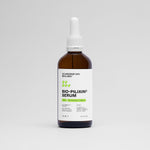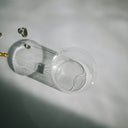Finasteride is a widely prescribed medication used primarily to treat male pattern baldness (androgenetic alopecia) and benign prostatic hyperplasia (BPH). While it’s effective for many, some users experience side effects that can range from mild to concerning. If you’re considering or currently using finasteride, you might be wondering about the potential side effects and, more importantly, whether they persist or resolve over time. This article dives deep into the question of finasteride side effects, offering clear answers, expert insights, and practical advice to help you make informed decisions about your health.
Table of content
Do Finasteride Side Effects Go Away?
Yes, for most people, finasteride side effects go away after discontinuing the medication. Common side effects like decreased libido, erectile dysfunction, and reduced ejaculate volume typically resolve within days to weeks after stopping the drug. However, in rare cases, some individuals report persistent symptoms—known as post-finasteride syndrome (PFS)—that may last months or even years. Studies suggest that these prolonged effects are uncommon, and for the majority, side effects subside once the body adjusts or the medication is stopped.
As your leading source for hair health information over the past 4 years, we never compromise on accuracy. When it comes to your health, you deserve information you can truly rely on - and earning your trust is our top priority.
Here's how Scandinavian Biolabs ensures every piece of content meets the highest standards of accuracy and integrity:
- Credentialed Experts: Our reviewers are actively practicing doctors and medical researchers
- Stringent Reviews: Content undergoes rigorous editing by subject specialists and review by a practicing doctor.
- Evidence-Based: We rely on well-established research from trusted scientific sources like peer-reviewed journals and health authorities.
- Full Transparency: Our editorial standards, writer credentials, reviewer credentials, correction process, and funding are all publicly documented.
- Independent Voice: While we do promote products, we operate in a vacuum to business operations. Our main goal is just an unwavering commitment to providing medically-sound guidance.
You can count on Scandinavian Biolabs to consistently deliver the trustworthy health information you deserve. Read our Editorial Standards.
What Is Finasteride and How Does It Work?
Finasteride is a 5-alpha-reductase inhibitor, a type of drug that blocks the conversion of testosterone into dihydrotestosterone (DHT). DHT is a hormone linked to hair loss in men with a genetic predisposition and prostate enlargement in older individuals. By lowering DHT levels, finasteride helps slow hair loss and shrink the prostate, alleviating symptoms of BPH. It’s available in two doses: 1 mg for hair loss (commonly sold as Propecia) and 5 mg for BPH (Proscar). Understanding how it works sets the stage for exploring its side effects and their reversibility.
Common Side Effects of Finasteride
While finasteride is generally well-tolerated, some users experience side effects. The most frequently reported ones include:
- Sexual Dysfunction: Decreased libido, erectile dysfunction, and reduced semen volume are the most common, affecting about 2-4% of users.
- Breast Changes: Some men report breast tenderness or enlargement (gynecomastia), though this is less common.
- Mood Changes: Anecdotal reports and small studies suggest potential links to depression or anxiety in rare cases.
- Skin Reactions: Rashes or itching occur infrequently.
These side effects are usually mild and reversible, but their duration and intensity can vary from person to person.
Why Do Side Effects Happen?
Finasteride’s side effects stem from its impact on hormone levels. By reducing DHT, it can subtly alter the hormonal balance in the body, which may affect sexual function, mood, or other systems. For example, DHT plays a role in libido and erectile health, so lowering it might lead to temporary disruptions. The good news? The body often adapts, and these changes are not permanent for most users.
How Long Do Finasteride Side Effects Last?
The duration of side effects depends on whether you continue or stop the medication. If you experience side effects while taking finasteride, they may persist as long as the drug is in your system. Finasteride has a half-life of about 5-6 hours, meaning it’s mostly cleared from your body within a day or two after stopping. For most people, side effects like sexual dysfunction resolve within a week to a month after discontinuation. Clinical trials, including those conducted during Propecia’s approval, found that 96-98% of men saw side effects disappear after stopping the drug.
However, timing can vary. Some men notice improvement within days, while others take a few weeks as their hormone levels normalize. Patience is key, but if symptoms linger beyond a month, consulting a doctor is wise.
What Is Post-Finasteride Syndrome (PFS)?
Post-finasteride syndrome is a controversial and rare condition where side effects persist long after stopping the drug. Symptoms reportedly include ongoing sexual dysfunction, depression, fatigue, and cognitive issues. While PFS has gained attention online and in patient forums, scientific evidence remains limited. A 2017 review in the journal PeerJ noted that persistent side effects occur in less than 1% of users, though exact numbers are hard to pin down due to underreporting and lack of large-scale studies.
The medical community is divided. Some experts argue PFS is real and tied to finasteride’s effects on neurosteroids (brain chemicals influenced by DHT), while others suggest it could be psychological or coincidental. If you’re worried about PFS, discuss it with a healthcare provider before starting finasteride.
Do Side Effects Go Away If You Keep Taking Finasteride?
Interestingly, some side effects diminish over time even if you continue the medication. The body can adjust to lower DHT levels, and mild issues like libido changes may fade after a few weeks or months. A study published in The Journal of Sexual Medicine found that among men who experienced sexual side effects initially, about half saw improvement without stopping the drug. This suggests that for some, persistence pays off—but it’s not guaranteed.
If side effects worsen or become intolerable, talk to your doctor about adjusting the dose or exploring alternatives.
Factors That Influence Side Effect Recovery
Several factors can affect how quickly (or if) side effects resolve:
- Age: Younger men may recover faster due to more resilient hormonal systems.
- Dosage: The 1 mg dose for hair loss typically causes fewer issues than the 5 mg dose for BPH.
- Duration of Use: Long-term use might delay recovery slightly, though evidence is mixed.
- Individual Biology: Genetics and baseline hormone levels play a role in how your body responds.
These variables make it hard to predict outcomes with certainty, but they highlight why personalized medical advice is crucial.
What to Do If Side Effects Don’t Go Away
If side effects persist after stopping finasteride, don’t panic. Here’s a step-by-step approach:
- Wait It Out: Give your body a few weeks to a month to readjust.
- See a Doctor: A healthcare provider can check hormone levels (e.g., testosterone, DHT) or rule out other causes.
- Explore Treatments: For sexual dysfunction, options like PDE5 inhibitors (e.g., Viagra) might help. For mood issues, therapy or medication could be considered.
- Report It: If you suspect PFS, report it to your doctor or the FDA to contribute to ongoing research.
Proactive steps can ease anxiety and address lingering symptoms effectively.
Alternatives to Finasteride
If side effects concern you, alternatives exist. Minoxidil, a topical solution, promotes hair growth without affecting hormones. Platelet-rich plasma (PRP) therapy and low-level laser therapy are emerging options for hair loss, though they’re pricier. For BPH, alpha-blockers like tamsulosin relieve symptoms without targeting DHT. Discuss these with your doctor to find the best fit.
Final Thoughts: Are Finasteride Side Effects Reversible?
For the vast majority, finasteride side effects are temporary and reversible, fading after discontinuation or even during continued use as the body adapts. While rare cases of persistent symptoms exist, they’re the exception, not the rule. Armed with this knowledge, you can weigh the benefits of finasteride—hair retention or prostate relief—against potential risks. Always consult a healthcare professional to tailor the decision to your unique needs.
Have you experienced finasteride side effects? How did they resolve for you? Share your story below—it might help someone else navigating the same choice.
Tired of Thinning Hair? Try a Clinically Tested Serum.
Looking for a natural way to regrow hair and achieve a thicker, fuller head of hair? Ditch the stinging nettle for hair loss – Bio-Pilixin Serum is a drug-free hair activation serum that delivers clinically tested results.
Here's why Bio-Pilixin is superior:
- Clinically Tested Results: 93% of users saw a reduction in hair loss, and 73% experienced increased hair density.
- Safe and Natural: Unlike harsh chemicals, Bio-Pilixin uses plant growth factors derived from stem cell technology to nourish hair follicles and stimulate growth.
- Fast-Acting: See visible results in as little as 45 days (most typically see results within 150 days).
Stop wasting time on unproven remedies. Bio-Pilixin is the safe, natural serum you've been searching for.
Read more:






